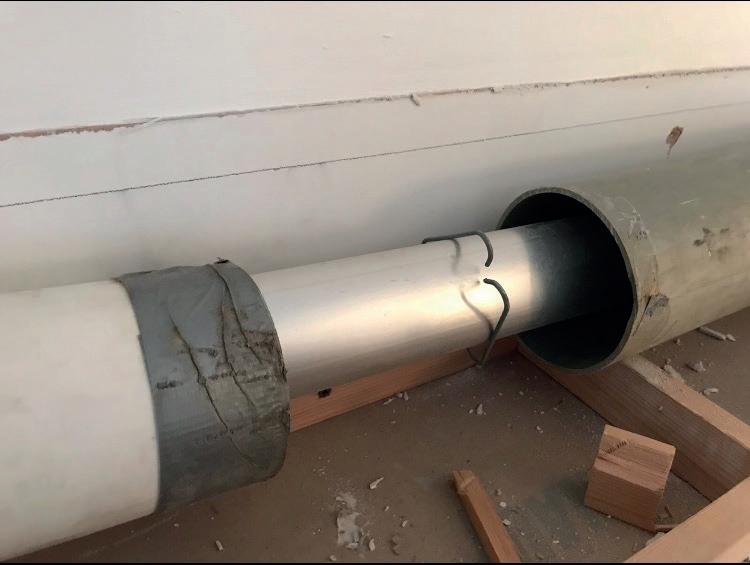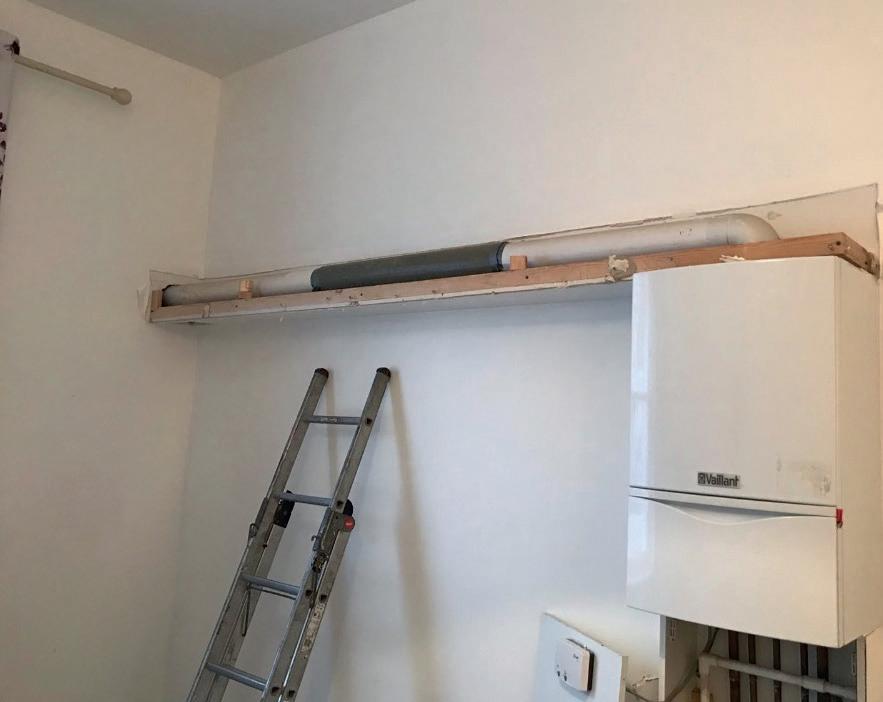
4 minute read
Flues in voids
Face to face with flues in voids
We’re always on the lookout for great stories and pictures that help bring to life some of the problems that you face in your day-to-day work. This month, we take a deeper look at an example of a chimney/flue in a void, sent in by Chris Riley from Sound Installations in Ware, Hertfordshire.

This month we particularly want to highlight these photos because they so clearly illustrate some of the problems that are hidden away in voids.They show why it’s so important to fully check the whole chimney/flue run behind a void.
Chris had been asked to replace a boiler in London. He says: “After removing the plastered-over boxing for the chimney/flue – which had no inspection hatches – I found that it had been installed using soil pipe, metal flue outlet pipe, along with a chimney from other manufacturers. The joints were taped together with duct tape. There was also no fall on the chimney/flue back to the boiler and no clips at all.”
Chris replaced the boiler, making sure that he fitted the new chimney/flue correctly.
Gas Safe Register’s Senior Technical Support Officer Ronnie McFarlane says: “This shows why it’s necessary for registered gas engineers to check the chimney/ flue in its entirety. It had not been fitted in accordance with the manufacturer’s instructions nor did it comply with BS 5440-1.”1
Technical Bulletin 008: Flues in voids
Technical Bulletin 008, developed by the Industry Flues in Voids Working Group, provides guidance on meeting the requirements of regulations when working on existing concealed room-sealed fanned-draught boiler chimney/flue systems in domestic premises.
Gas engineers have a legal duty to immediately examine and confirm the effectiveness of the chimney/flue whenever they undertake work on flued appliances (GSIUR – Regulation 26(9)). But this requirement can be difficult to fulfil in the case of concealed chimney/flue systems, such as those concealed in ceiling voids, many of which were fitted in flats built from around 2000 to 2007.
Concealed means situations where the chimney/flue system passes through ceiling voids, floor voids or behind false walls, etc.
TB008 provides guidance on how to deal with an existing concealed room-sealed fanneddraught boiler chimney/flue system. In order of preference, the guidance states that engineers should fit appropriately specified and located inspection hatches, room monitoring carbon monoxide (CO) alarms and ensure regular service/maintenance by a registered engineer.
To address situations where concealed chimney/flue systems cannot be visually examined and confirmed as being complete/ intact and effective, appropriately located and installed, inspection hatches are the most effective way of allowing the chimney/flue system integrity etc to be examined. This form of examination, along with the other operational safety checks necessary to confirm safe operation of the boiler as specified by GSIUR(1) 26(9), and the installation of room-monitoring CO alarms throughout the length of the flue route, will ensure as far as is reasonably practicable that the boiler and chimney/flue system are safe for continued use.
Fit a CO void monitoring safety shut-off system (COSSVM) and regular service/maintenance
In exceptional circumstances, the installation of inspection hatches may not always offer the best or a practical option to allow confirmation that the chimney/flue system is complete/intact and effective. For example, the enclosure around the chimney/ flue may be too small to allow effective examination of the whole
Can we help you?
When you call Gas Safe Register for technical support, it can be hard to describe what you’re seeing. Did you know that you can use video calling to the Technical Support Team, so that they can see what’s in front of you?
When you call them, they will ask whether you’d like to live stream a video call. The Register will then send a text message or email to your mobile phone, with a link so that you can use your phone camera to show the installation to the Technical Support officer. Simply follow the on-screen instructions to start video streaming – you don’t need to download any other apps or software. Note: The Technical Support team can give guidance on the classification of unsafe gas appliances, but the responsibility for classifying any unsafe gas appliances on site remains with the gas engineer. chimney/flue system, or there may be situations where the installation of inspection hatches could affect the building’s existing fire protection measures.
Systems capable of monitoring the void containing a concealed chimney/flue system for the presence of CO which, on activation will shut down the faulty boiler, may be considered as a method of providing an additional level of protection for property occupiers that do not have or agree to have inspection hatches installed.
This form of protection, along with the operational safety checks to confirm safe operation of the boiler as specified by GSIUR 26(9), as a minimum, will ensure, as far as is reasonably practicable, that the boiler and chimney/flue system are safe for continued use. Note: These systems are not a substitute for inspection hatches for new or replacement installations, which will need to meet the requirements of relevant Building Regulations/standards.
• You can read the full Technical Bulletin 008 by logging into your online account at www. GasSafeRegister.co.uk/sign-in
Bibliography
1 BS 5440-1:2008 – Flueing and ventilation for gas appliances of rated input not exceeding 70kW net (1st, 2nd and 3rd family gases). Specification for installation of gas appliances to chimneys and for maintenance of chimneys







